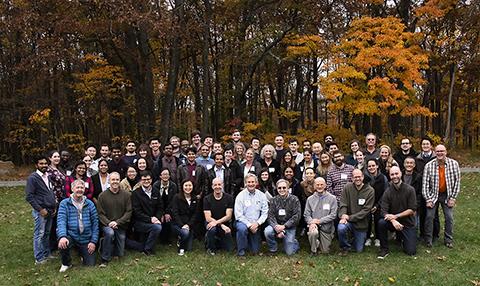Euna Yoo, Ph.D., has found what she calls “the perfect place” to begin her career as an independent researcher—the Chemical Biology Laboratory at NCI at Frederick.
The 11-year-old laboratory is an internationally recognized program that performs basic science to develop and apply chemical tools, methods, and materials to understand and alter biological processes involved in cancer and AIDS.
Yoo joined in September, becoming the lab’s newest and youngest principal investigator as well as the head of its Chemical Immunology Section. So far, she says, it has been a great experience.
“I like the idea of being driven by a shared mission,” she said. “Being at the NCI really motivates me toward a research direction to build a foundation and advance our scientific knowledge that helps improve cancer detection, treatment, and prevention.”
The Chemical Biology Laboratory’s senior-level investigators, including Yoo, lead independent research teams that are structured to offer intellectual freedom and a collegial atmosphere, like the faculty of a university’s chemistry department. Scientists share and refine each other’s ideas, becoming friends as much as coworkers.
“I feel like we really care for each other. Everyone wants me to succeed and offers help so that I can reach my goal and be most productive,” Yoo said. “So that’s been really great.”
That atmosphere is no accident, says Chemical Biology Laboratory Chief Joel Schneider, Ph.D., a former professor at University of Delaware at Newark. He thinks of the laboratory like his former faculty department and tries to create a place where scientists can grow and succeed. Each principal investigator has access to extensive support and has wide latitude to go after any new research challenge that arises within NCI’s mission.
For Yoo, that means an opportunity to apply her scientific strengths to the formidable team. She will conduct chemical immunology, aiming to find and design novel chemical approaches that can adjust the immune system’s responses to certain diseases. She’s still setting up her laboratory, but she hopes to soon develop new tools and probes that can aid her search.
Chemical immunology is a relatively new approach to cancer research and opens an innovative avenue for scientific advances. Investigators like Yoo harness the power of chemistry and the scientific understanding of the immune system to create methods for diagnosis and treatment that otherwise wouldn’t be possible.
Her research is a valuable addition to the Chemical Biology Laboratory’s already varied scientific palette. In several laboratories around the NCI at Frederick campus, her colleagues are probing chemical reactions, modifying existing molecules, and synthesizing new ones—all to study and treat a host of diseases.
For example, Schneider’s laboratory is developing pliable biomaterial implants that can adhere to patients’ tissues and deliver therapeutic drugs. One recent creation is designed to attach to the lungs and release molecules that halt the growth of mesothelioma, a cancer—often caused by exposure to asbestos—that occurs on the tissue covering many internal organs.
Terry Burke, Ph.D., and his team have created small protein-like molecules that attack different cancer and AIDS targets, while Joe Barchi, Ph.D., is developing gold nanoparticles that carry drugs directly to tumors and other targets. Mark Nicklaus, Ph.D., takes chemistry to the computer, working on digital techniques to screen, process, and study molecules with therapeutic properties.
Several investigators have also made an array of chemical tools. Jeff Gildersleeve, Ph.D., and colleagues created a technique for screening serum samples for markers that reveal how patients’ bodies respond to vaccines. Jay Schneekloth, Ph.D., and his team invented a robotically printed microarray that detects molecules capable of drugging RNA—something long considered impossible. Martin Schnermann, Ph.D., is developing fluorescent molecules that can be imaged for disease detection in dense tissue, overcoming a major limitation of traditional imaging techniques. Jordan Meier, Ph.D., is working on compounds that will help researchers understand how metabolic molecules contribute to disease by modifying patients’ genes.
Some of the lab’s treatments and tools have been licensed to companies or are currently undergoing preclinical trials.
“It makes coming to work fun because we’re a pretty diverse crowd, but we all speak the same language of chemistry,” Schneider said.
Scientific diversity has been central to the Chemical Biology Laboratory’s ethos throughout its existence. Even its founding in 2009 was, in part, an effort to diversify and expand the capabilities of its forerunner, the 40-year-old Laboratory of Medicinal Chemistry. More recently, the staff has begun planning to branch out yet again by establishing a dedicated medicinal chemistry program to translate promising compounds into new therapeutic drugs.
The lab is also trying to increase staff diversity in senior positions. Yoo is the first female principal investigator in the lab’s history and was hired as part of an initiative to recruit female scientists to the senior staff. Another female principal investigator is scheduled to join in early 2020.
Though Schneider and Yoo admit there’s room for growth in that area, Yoo says that the progress is important and—combined with her colleagues’ expansive scientific exploits—another indicator that she has found her ideal laboratory.
“Not only are we trying to do good science and make a positive impact, but … we are also aware that we need to provide good training opportunities and help navigate the career development for young scientists. It’s a real blessing for me to be part of those efforts,” she said.


